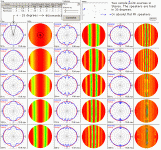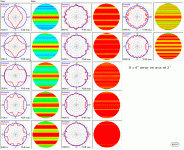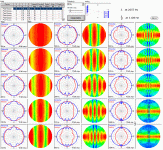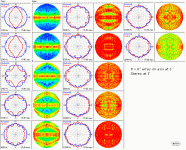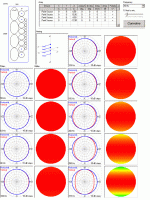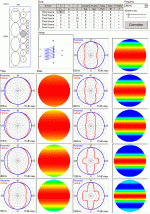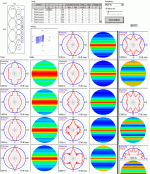Hey
All this is, is a simple quick fun speaker project that I want to do and ask a few questions about
what I want to do:
There are these silver Jaycar budget car speakers in the form of a 6x9, with there covers on they look quite industrial and
hardy, they are 4 ohms each and are 5 way coaxials and I want to buy 8 pairs, installing 8 per speaker resulting in an 8 ohm load which I want.
I dont want like some super duper high end speaker but want to turn them into a party music pumping machines, I can get 8 pairs for $320 AU here in Tasmania
I want bass only down to about 50 hz or lower and im prepared to make the enclosure 1.5 metres high and upto 50cms back and 30cm wide and it must be vented or slealed nothing else
I just want to ask what to watch out for? and any comments, because I haven't found a thing on line arrays for coaxial speakers
All this is, is a simple quick fun speaker project that I want to do and ask a few questions about
what I want to do:
There are these silver Jaycar budget car speakers in the form of a 6x9, with there covers on they look quite industrial and
hardy, they are 4 ohms each and are 5 way coaxials and I want to buy 8 pairs, installing 8 per speaker resulting in an 8 ohm load which I want.
I dont want like some super duper high end speaker but want to turn them into a party music pumping machines, I can get 8 pairs for $320 AU here in Tasmania
I want bass only down to about 50 hz or lower and im prepared to make the enclosure 1.5 metres high and upto 50cms back and 30cm wide and it must be vented or slealed nothing else
I just want to ask what to watch out for? and any comments, because I haven't found a thing on line arrays for coaxial speakers
not very good idea for few reasons
first, in your arrangement, tweeters will be far apart, comb effect, loss of hights, not good
second, car speakers, especialy 5 way coaxials, are most likely not high quality units, not designed for pa application
you might end up with disappointment
you would be far better of making just a two way pa speaker,
let say eminence 15" woofer and compression horn midrange/tweeter
or get sammi sound coaxial
http://www.partsexpress.com/pe/showdetl.cfm?&Partnumber=299-766
first, in your arrangement, tweeters will be far apart, comb effect, loss of hights, not good
second, car speakers, especialy 5 way coaxials, are most likely not high quality units, not designed for pa application
you might end up with disappointment
you would be far better of making just a two way pa speaker,
let say eminence 15" woofer and compression horn midrange/tweeter
or get sammi sound coaxial
http://www.partsexpress.com/pe/showdetl.cfm?&Partnumber=299-766
Toast Master,
Have your read the research paper that defines how to make line arrays for your living room? These are called "Near field Line Arrays". The paper was written by Jim Griffin, PHD.
If you follow the design parameters you will be able to make an expensive or an inexpensive line array.
You can find it here: http://www.audiodiycentral.com/awpapers.shtml
Then you can do much of this on your own, and come back and show us what you designed and built. Nearfield Line Arrays have their own rules. You can't just slap them together like you can a set of point source speakers. No lie:
Email me if you have more questions.
Zarathu
Have your read the research paper that defines how to make line arrays for your living room? These are called "Near field Line Arrays". The paper was written by Jim Griffin, PHD.

If you follow the design parameters you will be able to make an expensive or an inexpensive line array.
You can find it here: http://www.audiodiycentral.com/awpapers.shtml
Then you can do much of this on your own, and come back and show us what you designed and built. Nearfield Line Arrays have their own rules. You can't just slap them together like you can a set of point source speakers. No lie:

Email me if you have more questions.
Zarathu

...I dont want like some super duper high end speaker but want to turn them into a party music pumping machines...
Nice idea, could work as intended….I took this concept and played with it…..See picture.
The 6”x9” divers could also work well in a compact stand-box placed below a 2-way array.
Notice the removed coax-tweeters and new placement that really is necessary for good performance.
b
1(1)
Attachments
Nice bjorno, thanks for the input all, I have read the papers you posted adason and I have taken some of it in but this is just for fun and simplicity, If I am disapointed owell at least it will look awesome and its not like my freinds are gonna get there sine generators and spl meters out and judge them, this is purely for fun and honestly if I wanted to make an uber speaker why would I use 6x9s from a budget car company lol, not that I dislike them, I rather like them
From experience and knowledge from you guys I want to simply know what effects this plan will have
as you can see in the picture that bjorno posted, there are silver 6x9s
my plan is to stack them side ways as close as possible going vertical so the minimum height would be 8 x 15cms = 120 cm + ports and walls and grills spaces approx 140cm per speaker
doing this I know comb effects will be in the max and lobing too but will this be so noticable to the untrained ear that even average teens and adults are gonna be able to say "geez I can so tell theres a 4 db dip at 4khz and and OMG theres a 6 db drop at 10khz"....
lol what I ment to say is, how will this sound, assuming I get the volume right and crossover correct with the right port tune
or will there be so much cancellation it will be pointless...
comments and insults are welcome 🙂
thanks for the help
From experience and knowledge from you guys I want to simply know what effects this plan will have
as you can see in the picture that bjorno posted, there are silver 6x9s
my plan is to stack them side ways as close as possible going vertical so the minimum height would be 8 x 15cms = 120 cm + ports and walls and grills spaces approx 140cm per speaker
doing this I know comb effects will be in the max and lobing too but will this be so noticable to the untrained ear that even average teens and adults are gonna be able to say "geez I can so tell theres a 4 db dip at 4khz and and OMG theres a 6 db drop at 10khz"....
lol what I ment to say is, how will this sound, assuming I get the volume right and crossover correct with the right port tune
or will there be so much cancellation it will be pointless...
comments and insults are welcome 🙂
thanks for the help
From experience and knowledge from you guys I want to simply know what effects this plan will have---- or will there be so much cancellation it will be pointless...
Here you have an opportunity to make a decision on your own if you should stay with the 6”x9” coax drivers in a simple row.
Take a look at all the submitted plots but do not expect your drivers have comparable levels outside the plotted +- 15 degrees response without taken into account the actual driver off axis response levels that always must be considered instead of the shown point sources omni dispersion.
First shown is the combing effect for single driver speakers that never can be circumvented even for prefect FR flat speakers. One conclusion is that for a given stereo set-up there is a best sweet spot, where only one unique always-rippled or non-flat speaker minimum phase FR curve that provides flat FR response to the ears.
Also noticed from the plots: If using the coax drivers in a single array column, then at about 0.9 x Lambda (valid for a typical 8-array) the vertical directivity drops down 5.5 dB causing more sound energy to be perpendicular directed instead (indoors to the floor and ceiling) to the audience destroying the sense of scene size and at an octave above the beaming is in near full bloom.
Array designs with crossovers at these frequencies trying to defeat these anomalies are doomed to still produce low audio qualities (phantom location, image split and tone coloration) even if using high order filters they also give array speakers a bad reputation when compared to more common speaker designs.
If I had the opportunity to test those coax drivers in an array I would use a Low-Pass filter crossing over the 6x9” drivers at lambda/8 to 3”-4” drivers, for the need of wide ‘Party’ dispersion and if the tweeters normally are crossed over at higher frequency when compared to the 3-4” drivers, I would try to use into a simple wave guide too.
The last three plots are reflecting my first proposed far field 3-way 1 m array and possible work bandwidths.
b
Attachments
I am so "reading/listening" but any fool can do that, I just don't understand, This is a new area for me, and because it is, I though the easiest way would be with Coxials wired to a certain impedence (8) and giving them a simple 6th order high pass (capacitor) around 40- 80hz
But from what I see this is a very complex type of speaker or the effects are and im not exactly the smartest cookie
All I was hoping for was for every doubling of cone area that I would get +3 db, so because there original spl is 87 db at 1 watt/meter @ 8 ohms so with 8 I should get 96 db sensivity
thanks for all your time and effort bjorno
because my woodwork skills are rather good I wanted to make a solid, heavily braced speaker box housing these 6x9's but I feel this "simple" plan is to be scrapped lol
I didnt expect such dedication from other members 🙂
thanks
Ps another question, Would less drivers has less of a blooming/strobing/combing effect? for eg. like using only 2 drivers?
As you can sense I really wanna start designing/building the box! 🙂
But from what I see this is a very complex type of speaker or the effects are and im not exactly the smartest cookie
All I was hoping for was for every doubling of cone area that I would get +3 db, so because there original spl is 87 db at 1 watt/meter @ 8 ohms so with 8 I should get 96 db sensivity
thanks for all your time and effort bjorno
because my woodwork skills are rather good I wanted to make a solid, heavily braced speaker box housing these 6x9's but I feel this "simple" plan is to be scrapped lol
I didnt expect such dedication from other members 🙂
thanks
Ps another question, Would less drivers has less of a blooming/strobing/combing effect? for eg. like using only 2 drivers?
As you can sense I really wanna start designing/building the box! 🙂
First I would like to say that I really like forum this new style and second we're talking about coaxial car speakers, the tweeter has a waveguide that's meant to fire clear of the woofer and the woofer actually barely moves anymore. the 1st gen uni Qs relied on the woofer as it's waveguide which was actually the first patent. it was only recent child patents that covered the relationship between the two while the tweeter now has its own stationary compression horn style waveguide.Hey
All this is, is a simple quick fun speaker project that I want to do and ask a few questions about
what I want to do:
There are these silver Jaycar budget car speakers in the form of a 6x9, with there covers on they look quite industrial and
hardy, they are 4 ohms each and are 5 way coaxials and I want to buy 8 pairs, installing 8 per speaker resulting in an 8 ohm load which I want.
I dont want like some super duper high end speaker but want to turn them into a party music pumping machines, I can get 8 pairs for $320 AU here in Tasmania
I want bass only down to about 50 hz or lower and im prepared to make the enclosure 1.5 metres high and upto 50cms back and 30cm wide and it must be vented or slealed nothing else
I just want to ask what to watch out for? and any comments, because I haven't found a thing on line arrays for coaxial speakers
- Home
- Loudspeakers
- Multi-Way
- coaxial Line Array Questions/comments

